The Mayor
Washington's—and GW's—Vincent Gray
District of Columbia Mayor and George Washington University graduate Vincent Gray, BS '64, is a man who thinks in a deliberative and comprehensive fashion.
Plodding, process-driven, and wonky are all words used to describe the man who became the sixth mayor of the District of Columbia Jan. 2.
They are also words that belie the man.
Compared to the youthful, triathlon-competing former Mayor Adrian Fenty, Mr. Gray can be depicted as slow and mired in following convention.
But what is seen as plodding can best be understood by studying the forces that forged the city's new mayor. Mr. Gray was formed at a time when hearing and listening were crucial, nay critical skills for a young black man coming of age in a segregated society.
To understand Mr. Gray, one must look at the District of Columbia that existed when he grew up.
![]()
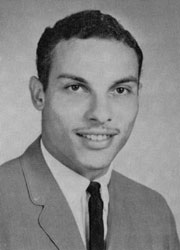
Vincent Gray's 1964 Cherry Tree yearbook photo. While at GW, Mr. Gray participated in the integration of the GW fraternity system by pledging the Tau Epsilon Phi fraternity in October 1963 along with two other African American students: Garry Lyle, BA '72, and Robert Wright, BA '66. He subsequently served two terms as TEP's president. He also participated actively in intramural sports through the fraternity and frequently played basketball in the Tin Tabernacle.
Photo courtesy of GW's Special Collections Research Center at the Estelle and Melvin Gelman Library. For more information on Mr. Gray, visit the library's GW and Foggy Bottom Historical Encyclopedia online.
Vincent Gray was born Nov. 8, 1942, at the old Freedmen's Hospital on the grounds of Howard University. Under the city's strict segregation laws, it was one of a few black hospitals in the District, so it was likely that he would be born there. And his father worked there.
Mr. Gray's father grew up outside D.C. in Brandywine, Md. Neither parent attended high school. His father drove a taxi at night after he got off work from his job at Freedmen's. His mother stayed at home to care for Mr. Gray and his brother in a one-bedroom apartment in the Northeast sector of the city.
Like many boys of his time, Mr. Gray played baseball. "Not to be self-aggrandizing, but I was really a ball player from the moment I picked up a bat," Mr. Gray says. His youth league was located at the Sherwood Recreation Center at the corner of 10th and G streets, Northeast.
"I played four years of 12-and-under ball, to the point where they thought I was too old because I was able to outplay everybody by the time I was 12."
In the 11th and 12th grades, Mr. Gray hit over .500. The White Sox and Dodgers were scouting him.
Instead of becoming one of the few blacks playing professional baseball, Mr. Gray decided to forgo the opportunity and enter college.
"I really fundamentally questioned whether I was ever going to be able to make it. If I'd gone to the minor leagues, which I think I could've done, would I just bounce around? During those days, the minor leagues were really a rough experience. They didn't pay very much, and I wouldn't have been in school.
"At the end of the day, my concern was whether I would've been without an education and without a baseball future," Mr. Gray says.
Much of the Vince Gray that District of Columbia residents came to know during the 2010 mayoral campaign is a Vince Gray also indelibly shaped by his time as one of the first black students at the George Washington University.
In 1954, GW lifted all restrictions on minority student admissions. Vincent Gray arrived on campus a few years afterward.
Mr. Gray came to GW as a 16-year-old graduate of the pre-eminent high school for blacks in D.C.: Paul Lawrence Dunbar High School, known for its rigorous academic. Many of the school's graduates were destined to pursue stellar careers in a variety of fields. The school's famed alumni included black historian Carter G. Woodson; Edward Brooke, the first black elected to the U.S. Senate by popular vote; D.C.'s congressional representative, Delegate Eleanor Holmes Norton; and surgeon Charles R. Drew.
When Mr. Gray arrived on the GW campus, there were about 25 black students in a student population of approximately 15,000.
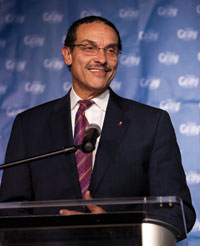
Vincent Gray celebrates his win in the September 2010 primary election. He went on to be inaugurated in January, when more than 20 of his GW Tau Epsilon Phi fraternity brothers in attendance were acknowledged by Mr. Gray.
William Atkins
"The African Americans kind of banded togethe. We were very different people, but I think the common denominator was that we were all African American," Mr. Gray says. "I'm not sure we would have come together in that way had we been in a situation that was more diverse, more populated with African Americans, because there were a lot of personality differences in the 25 or so folks who were there."
Mr. Gray went to GW because his parents wanted him to. "There was something about George Washington University that they liked."
It wasn't easy.
"My first year there I was given what I think was bad advice. They had me taking 18 semester hours, which—when you do the math—you need 120 to graduate, so that is an average of 15 a semester. And not only was it 18 semester hours; it was zoology, it was chemistry, it was European history, German—it was a hugely challenging set of courses."
It wasn't just the coursework. Mr. Gray recounts a classic early '60s integration story: "I had one teacher, an English lit. teacher, who looked at me differently than he looked at other folk in the classroom.
"Nobody made the blatantly racist statements; you could just feel that you were not accepted. You were viewed as different. And not in a positive way."
Mr. Gray called those years "a really difficult experience."
"After that first year—given what I'd gone through—I really wanted to leave."
Two other students from Mr. Gray's class at Dunbar also went to GW.
"They couldn't take it anymore so they left," Mr. Gray says. "I was at the threshold of doing the same thing, but I didn't."
Mr. Gray talked to his parents. He knew they would have supported any decision he made, but he could see that they were disappointed at the decision he was about to make.
So, he reconsidered. "I realized that there were going to be a lot of tough decisions … and the question is do you step to it or do you walk away from it and I decided that I needed to step to it."
In his junior year, Mr. Gray decided to join a fraternity.
Most, if not all, of the fraternities at GW had national charters that prohibited blacks and Asians from membership.
"It was as much a civil rights statement as it was a social statement for me," he says. There had never been an African American in a fraternity at George Washington."
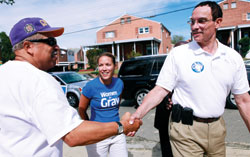
Richard Patterson, left, shakes the hand of District of Columbia Council Chairman, and mayoral hopeful, Vincent Gray, right, as Gray visits a polling station in Washington, Tuesday Sept. 14, 2010, the day of Washington's mayoral primary. At center is Gray's daughter, Jonice Gray Tucker.
AP Photo/Jacquelyn Martin
In those days, prospective fraternity members had to visit each house during pledge week. They had to visit for at least 20 minutes and each fraternity had to sign a card to show that the prospective pledge had visited.
One house, Mr. Gray recounts, sent word: "Just send your card, we'll sign it. We don't want you to come up here."
At another house Mr. Gray sat ignored for the entire 20 minutes.
"Nobody acknowledged that I existed, and so I got up after 20 minutes. They signed my card and I left."
It wasn't just blacks that the fraternities didn't want.
George Washington University graduate Bruce Bereano, BA '66, JD '69, who is Jewish, went through the fraternity pledge process two years before Mr. Gray and remembers his visits to two houses. "They said, 'Don't bother, just move on.'"
It was Mr. Bereano's first experience of anti-Semitism.
He joined the university's Jewish fraternity, Tau Epsilon Phi (TEP).
According to the fraternity's website, TEP was exclusively Jewish until the mid-1950s when it began allowing non-Jewish, mostly Catholic members. Blacks and Asians were still prohibited from membership.
Mr. Gray stopped by TEP to get his card signed.
Mr. Bereano liked Mr. Gray immediately.
"He conveyed himself as a sincere, down-to-earth person; warm, friendly, sophisticated, and intelligent," Mr. Bereano says.
Mr. Bereano wanted to accept Mr. Gray as a member. The brothers met. Mr. Bereano recalls the heated conversations about whether to accept Mr. Gray.
"If you don't let him in, I'm leaving," Mr. Bereano recalls saying. "I don't want to be associated with a bunch of bigots."
"We're Jewish," Mr. Bereano implored his brothers. "We've been persecuted."
Mr. Bereano and the more liberal members of the fraternity prevailed, and Mr. Bereano became Mr. Gray's big brother.
Mr. Gray, along with two other men, Garry Lyle and Robert Wright, became the first black men admitted to TEP. The broken color barrier garnered local media interest and a story in The GW Hatchet.
Mr. Gray's path to becoming chancellor (president) of TEP seems eerily prescient. As Mr. Gray recounts the tale, there was an heir apparent who was expected to become the chapter's next president. A few fraternity members felt the chapter needed to go in a different direction and they recruited Mr. Gray to run.
TEP was on the verge of bankruptcy. As the two candidates faced off, Mr. Gray was surprised to hear his opponent pledging to hold more parties.
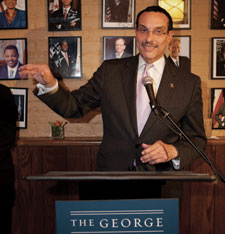
Mr. Gray spoke to nearly 200 alumni Nov. 17 at GW's annual D.C. Government Alumni Reception, held at the U Street restaurant Ben's Next Door.
William Atkins
"'Parties?'" Mr. Gray recalls saying. 'This fraternity is about to be financially sunk. You're not even addressing the real issues. The future of the fraternity is potentially in peril.' So, I made a speech about how we had to straighten out the operation of the fraternity."
Mr. Gray won the election. He closed the fraternity's kitchen and instituted other cost-saving cuts to shore up its finances.
He was chancellor for two consecutive terms.
Lawyer Kenneth Trombly, BA '70, met Mr. Gray as a freshman during Rush Week in the fall of 1966.
He found himself drawn to TEP.
"I was impressed by the diversity and feeling of warmth and welcomeness," he recalls.
Mr. Gray had graduated and was attending graduate school by the time Mr. Trombly arrived at GW from Newton, Mass. Mr. Gray, he says, was kind of a "senior statesman and highly regarded" by the undergrads.
"We looked up to him," Mr. Trombly says simply.
Mr. Trombly didn't get to know Mr. Gray personally until many years later. The age chasm between a freshman GW student and former president of a fraternity had narrowed by the time Mr. Trombly began to raise money for his TEP brother to run for public office. The friendship deepened. The traits that Mr. Trombly saw as a young man had remained. The charisma and empathy that so impressed him were now used in service to the city he had come to love.
![]()
Vincent Gray took a circuitous route to elected office.
After receiving his master's degree, he began his career in 1966 by working for the D.C. Association for Retarded Citizens (now known as The Arc of D.C.). The organization came to Mr. Gray's attention because of his undergraduate and graduate professor Dr. Eva Johnson. She was involved with the group and encouraged Mr. Gray to focus his career on people with intellectual and developmental disabilities.
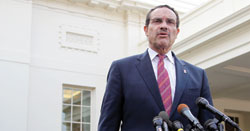
Washington Mayor-Elect Vincent Gray speaks to members of the media, outside the White House in Washington, Wednesday, Dec. 1, 2010, following his luncheon meeting with President Barack Obama.
AP Photo/Pablo Martinez Monsivais
Mr. Gray viewed his job with the organization as an extension of his work integrating GW: "a civil rights battle" to get people with mental retardation out of institutions and living in their community.
Mr. Gray's actions helped Steve Sellow, a man with mental retardation, to be released from the city's Forest Haven institution. Calling Mr. Sellow "one of the most self-actualized people I know," Mr. Gray tells of Mr. Sellow running for a seat as D.C.'s nonvoting "shadow" senator. Mr. Sellow became a popular and well-known member of his community and even had part of a street in Northeast Washington named after him in 2000.
Along the way, Mr. Gray took time to marry and raise a family. He married his wife, Loretta, at D.C.'s oldest church for black Catholics, St. Augustine's. Loretta, who died in 1998, was a long-time teacher in the District's public schools. They had two children, Jonice and Vincent Carlos.
Mr. Gray's work with The Arc over 25 years brought him to the notice of the city's political establishment. He first came to local prominence in 1991 when Mayor Sharon Pratt Kelly tapped Mr. Gray to lead the city's troubled Department of Human Services.
Mr. Gray's focus on serving the District of Columbia community continued after he left the human services agency at the end of Ms. Pratt Kelly's mayoral term in December 1994. Mr. Gray went on to found and become the first executive director of the D.C. branch of Covenant House, an international, faith-based organization that assists homeless and at-risk youth.
After a decade with Covenant House, Mr. Gray found himself in a familiar situation. Residents of Ward 7, where Mr. Gray resided, asked him to run for a seat on the District of Columbia's City Council against powerful incumbent Kevin P. Chavous. They felt Mr. Chavous had not brought the services and economic development that the ward needed and that his work at a tony downtown law firm took away from his work on the council.
Mr. Gray pledged to quit his job at Covenant House to become a full-time councilmember. His campaign focused on five issues: public education, affordable housing, health care, economic development, and public safety. These issues, he said, were key and closely related to the ward's health.

Mr. Gray gives a pre-game pep talk to the men's basketball team Jan. 5 for the team's home opener against La Salle, which GW won 72–67.
William Atkins
In an initially crowded field, Mr. Gray quickly became Mr. Chavous' main opponent. He won the September primary by 17 percentage points and went on to win the council seat. He was sworn in as a member of the council Jan. 2, 2005.
When council Chair Linda Cropp decided to give up her seat and run for mayor, Mr. Gray launched a bid for her seat. He easily bested his opponent, Kathy Patterson, by touting his ability to build coalitions.
Mr. Gray's term as council chair has been viewed as particularly successful. He is proud that as chair he solicited input from all councilmembers and ensured that each felt that his or her input had been heard and addressed before moving legislation forward. He even allowed a hearing on Michelle Rhee and the school system to go on until 4 a.m. so that everyone who showed up could testify.
Mr. Gray's penchant for seeking widespread input on issues and coalition-building led a group of citizens to lobby him to run for mayor against Adrian Fenty.
Mr. Gray took his time before ultimately deciding to run.
"It was the insular, exclusionary approach to governing that really bothered me," says Mr. Gray of Mr. Fenty's term and Ms. Rhee's management style. "I'm a very inclusive person. I believe in the reality that we live in a democracy. I believe in it even more here, where we experience less of a democracy than most places because we are the District of Columbia. So why would we want to live in a situation where our own leaders treat us that way?
"I had worked with this administration for four years, and it was very painful for me to see how people were treated, how people were oppressed.
"I felt frankly that the city needed a change," Mr. Gray says.

Mr. Gray and former GW TEP alumni friends and intramural sports teammates Stephen Haenel, AA '64; Neil Hausig, BA '65; Garry Lyle, BA '72; and Norm Neverson, BA '67, were acknowledged on the court during the game.
William Atkins
Mr. Gray set out to make that change happen with a campaign focused on uniting the city's fragmented elements: black, white, Latino, gay, straight, young, and old—the campaign was One City.
The District of Columbia is a Democratic town. The September primary is the real harbinger of who will run the city. After Mr. Gray defeated Mr. Fenty in the Sept. 10 primary, he embarked on a series of town hall meetings—one held in each of the city's eight wards—to hear about citizen concerns. It was also a way for Mr. Gray to allay the fears of the residents that had not backed him. Three of the city's eight wards were overwhelmingly white and peopled with residents who feared that Mr. Gray was another Marion Barry (D.C.'s former longtime mayor). Mr. Fenty carried those wards, filled with residents firmly committed to schools Chancellor Michelle Rhee. They viewed Mr. Gray with suspicion. As chair of the city council, Mr. Gray had long-term battles with Ms. Rhee over her decision-making style.
Mr. Gray won the residents over with a series of moves rooted in his experiences and true to himself.
When Marion Barry was voted in to a fourth mayoral term after his drug use conviction by an overwhelmingly black majority, he told the residents who backed his opponent to "get over it."
That's not a move in Vincent Gray's handbook. He sent a signal to residents worried about his commitment to education by naming Ms. Rhee's second-in-command, Kaya Henderson, to run the school system. Their styles of working through collaboration meshed.
It's worth noting that Mr. Gray is the only council chair who has gone on to become mayor. He held unprecedented power after he won the election, becoming the first in the history of D.C.'s home rule to simultaneously hold the position of chair and mayor-elect.
![]()
It's a temperate December morning about six weeks before Mr. Gray's inauguration. He is in the Wilson Building (the District of Columbia's city hall) on a Saturday to meet with newly elected advisory neighborhood commissioners, the grassroots of city elected officials.

Mr. Gray was the guest of honor at a Jan. 13 breakfast at GW, where the university celebrated Mr. Gray's mayoral win. President Knapp called Mr. Gray's story "sobering and inspiring" and said GW was pleased to honor Mr. Gray for both his public achievements and, belatedly, for his role as a civil rights pioneer within the university. Mr. Gray has maintained close ties to GW, including enlisting some GW students, such as graduate student Anna Phillips, BA '07, in his campaign.
William Atkins
Mr. Gray is at the front of the D.C. City Council's alternate hearing space. More than 150 people crowd the room. His attire does not suggest a dandy, but rather a man who is conscious of his clothing; in this case, a V-neck burgundy sweater over brown khakis. If you look closely, you can see "Vince" embroidered in maroon peeking out from the sleeve of his sweater on the left cuff of his white-checked shirt.
Mr. Gray is patiently answering questions. He listens intently to each question and fixes his gaze on the questioners. He nods to show he's listening, and he shows no impatience and uses no notes as he speaks extemporaneously on subjects ranging from Wal-Mart's newly announced arrival in the District to the endemic joblessness in wards seven and eight.
As the event ends, Mr. Gray moves slowly toward the exit surrounded by people. He doesn't rush and gives each person his full attention, all the while moving toward the elevators.
This behavior exemplifies what seems to be at the core of Mr. Gray's beliefs, shaped by his experiences and a wish to treat others the way he has always hoped to be treated. He has built a public service career on the fundamental notion that all persons should be heard and valued, and that decisions should be made carefully only after hearing all concerns.
These are qualities his GW TEP brothers remember.
"Don't forget he was a psych major," Mr. Bereano says. "Psych: the science of human relationships."
Mr. Trombly prides himself on being a bit of a visionary, noting that he saw Mr. Gray as mayor years ago. He has proof. In early 2006, a reporter from The Washington Post covering Mr. Gray's bid for council chair included a quote from Mr. Trombly in his story: "I'm sure I'm not the first one to say this, but in five years, he'll be mayor."

